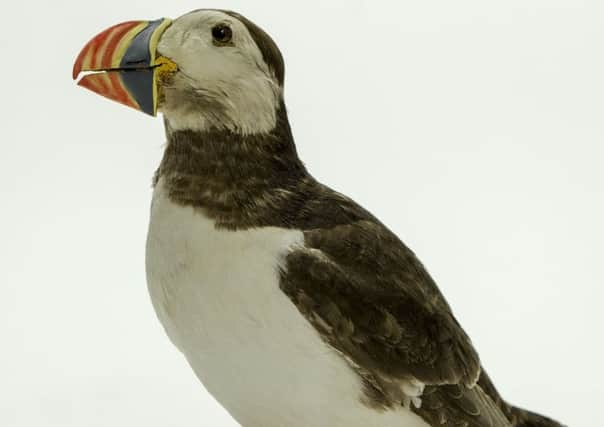Exhibit of the Week: Remarkable creature alarmingly on red list


These chirpy little chaps are a familiar sight on the Yorkshire coast, with a much-needed stronghold just 20 or so miles south of Scarborough at the RSPB reserve at Bempton Cliffs. You can occasionally spot them bobbing about on the water off the Marine Drive, too. But for how long?
The puffin has recently been moved onto the ‘red’ list on the Birds of Conservation Concern (BoCC) listings, meaning it’s high priority in terms of conservation, and needs urgent action. There it joins birds that you might naturally assume to be rare or threatened in this country, such as the ring ouzel and the capercaillie, but also less obvious red listers such as the house sparrow, starling and kittiwake.
Advertisement
Hide AdAdvertisement
Hide AdWhen the puffin joined the red list last autumn, the RSPB pointed out that it’s an indicator of a much wider problem. Dr Mark Eaton, one of the RSPB’s Principal Conservation Scientists, said: “We’re seeing kittiwakes, puffins and shags join the red list this time around. So we’re particularly worried about what’s happening to our marine ecosystems and the impact that’s having on our seabirds.”
He pointed out, however, that the situation is far from irreversible: “The very first red data book had a red kite on the cover because it was a perfect example of a threatened bird, hanging on in a just a few Welsh valleys, but now they’re widespread, a common sight in many places.
“What’s particularly pleasing is that thanks to the support of from our members, and partners from other organisations we have been able to demonstrate that we can turn things around if we have resources and support.
“It’s not a one-way journey – we can bring them back.”
Around a quarter of a millions seabirds crowd onto the cliffs between Bempton and Flamborough each spring to breed, including majestic gannets, razorbills, guillemots, kittiwakes and, of course, from mid-April to mid-June, puffins – a 2005 estimate suggested that there were around 6,000 of them, but their secretive nesting habits in underground burrows make them difficult to count and, of course, since then they’ve been red listed.
Advertisement
Hide AdAdvertisement
Hide AdTake another close look at our puffin – they really are the most remarkable-looking creatures, but have become so familiar to us, not least as the logo of the much-loved children’s books, that we often don’t look twice.
Our specimen, from the taxidermy section of the Scarborough Collections, was probably collected in Victorian times, so his vivid colours have faded over the years. In real life, that smart monochrome plumage is offset by the most vibrant of colours – lifebelt-orange feet, blue, red and yellow bill, and those extraordinary eye ornaments – patches of horny, blue-grey skin – which give the bird a rather melancholy aspect. The whole combines into a most appealing package.
Properly called the Atlantic puffin, the bird’s biggest concentration is in Iceland, where around 60% of the world’s population nests – they are still hunted for food both there and in the Faroe Islands; smoked puffin with blueberry sauce is considered something of a delicacy.
You can see our stuffed puffin at the Rotunda at the moment, where he’s part of a display celebrating spring on the Yorkshire coast. And if that whets your appetite to see the real thing, try paying a visit to Bempton Cliffs – it’s a glorious sight at this time of year, and the reserve is marking the coming of spring this month with a series of guided puffin patrols, seeking out the secret places where they like to nest, and puffin trails.
Advertisement
Hide AdAdvertisement
Hide AdThe puffin is part of the Scarborough Collections, the name given to all the museum objects and artwork acquired by the borough over the years, and now in the care of Scarborough Museums Trust. For further information, please contact Collections Manager Jennifer Dunne on [email protected] or 01723 384510.